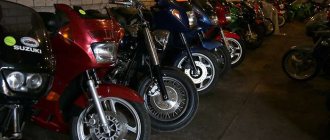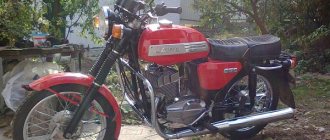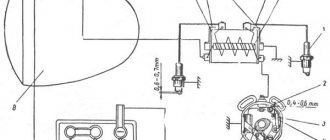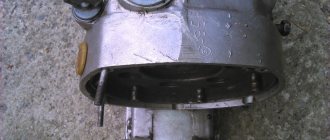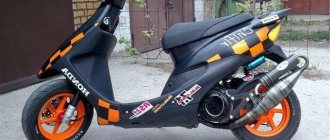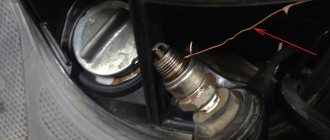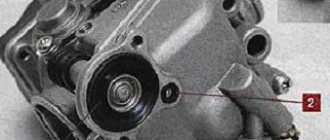Day after day, time after time, the same questions are asked about buying a motorcycle: new or used, China or Japan, more powerful or fresher, chopper or scooter, with documents or stolen. Today we will look at the question of China/not China. Fact one: not all narrow-eyed people are equally useful. Despite the fact that China, Korea, and Japan have been producing motorcycles for a long time, they differ in their consumer qualities much more than yellow-faced engineers. Due to the Japanese mentality and cultural characteristics, making a low-quality product is a waste. For the domestic market they create completely different cars and motorcycles than for the external market. The Big Four motorcycle manufacturers are huge concerns that produce not only motorcycles, but a whole lot of everything. To learn, they copied the best engineering solutions from European manufacturers for more than 50 years. We improved ourselves in local and world competitions, adjusted our products to different standards of different countries. As a result, fact two: the Japs produce high-quality, reliable equipment that, with proper maintenance, will last a long time and will delight you. Koreans are trying very hard to keep up with the Japanese. Most Korean motorcycle manufacturers are also part of large Korean concerns that also produce cars and all kinds of crap in the form of tankers, construction equipment, etc. They learned to make motorcycles from the Japanese in Japanese factories built in Korea, and continue to collaborate on various engineering issues. Fact three: Korean mopeds and motorcycles are no worse, but less flashy, and as a result are significantly cheaper. The Chinese... there are over 1.5 billion of them. The demand for two-wheeled vehicles is enormous; there are too many companies producing mopeds and motorcycles. There is no point for them to focus on quality - it is difficult. It’s easier to reduce the cost and sell cheaper and more. There are several large manufacturers that rely on the power of local concerns, but none of them have their own engineering school. There are no technologies (namely, not only drawings, but also manufacturing methods, choice of materials, tightening torques, fasteners, etc.). The engines are either honestly stolen from the Japanese or a hodgepodge from all over the world with local sauce. A wide variety of materials are also used. Instead of magnesium - silumin, instead of high-quality structural seamless pipes - plumbing chernyag. The design of Chinese crafts deserves a separate topic of conversation. And the best thing is that this entire festival, sold here, is assembled in the CIS by our local craftsmen with all the consequences from this: bolts hammered in with a hammer, dangling and fraying wires, pinched hoses, crooked tires, in a word, complete stuffing. just for those who squandered everything: As a result, the advantage is the low price for a new device, and for a used one it’s basically mere pennies. in most cases, it can be repaired with a hammer and electrical tape; the design and service life will not be affected. What's in the minus: -unpredictable build quality. you never know what will fall off and when. -unpredictable quality of materials. You’ll never guess whether the frame will crack and whether it can be welded later, whether the steering wheel will bend or break, whether the hoses will turn into plasticine or crack. -unpredictable spare parts. Do they exist in nature at all, will they fit from one “licensed” model to another, no less “licensed” - the resource is much, much, much less than that of the Japanese or European original. sometimes the resource runs out immediately after running in. or after the warranty expires. You'll never guess exactly when. - consumer qualities are generally on the brink: engines develop less power, the quality of finishing and the choice of finishing materials and linings are incomparably worse. the brakes don't slow down, the tires don't hold, the frame bends, the engine can't idle properly, doesn't pull at low speeds and wobbles at high speeds, the forks leak, the mufflers shoot, and it's unknown what specific set you'll get (it's a lottery!) Which manufacturer to choose - It’s up to you, personally, I won’t buy Chinese anymore. For me, a two-wheeled vehicle is a means of obtaining pleasure. Aesthetic, from driving, from owning, from realizing your new capabilities. Chinese crafts are much less pleasing than real motorcycles, much less than the difference in price.
Oh, yes, tuning, and I’m a guy with hands - I’ll fix it, it’s not hard for me... Fuck it. Attempts to squeeze out a little more documented capabilities cause a chain reaction. Neither the frame, nor the brakes, nor the tires cope with their duties even out of the box. and the daily application of hands here and there does not add any joy anywhere.
Hence the conclusion: the totality of consumer qualities of Chinese two-wheeled vehicles with a motor is much lower than the real price tag. Don’t be fooled by shiny things, beautiful numbers and similarities with real motorcycles, don’t buy Chinese guano, so as not to regret the money, nerves and time spent later.
50cc scooters
Let's take a closer look at each type.
50cc scooters are the most popular.
Their positive aspects:
- Acceptable price.
- Small size.
- Maneuverability.
- Convenient for moving around the city and using in everyday activities.
- They consume little fuel (2-2.5 liters per 100 km).
- Unpretentious in repair.
- Capable of reaching speeds from 50 to 90 km/h. Some models are capable of 100 km/h.
50 cc scooters
There is also the other side of the coin: an average speed of 60-70 km/h is often not enough. Most models are single-seater.
Scooters with a volume of 50 cubic meters are always available on the market in a wide range. The main part consists of Japanese and Chinese models. Japanese scooters are distinguished by excellent 2-stroke engines, which increases their agility and maneuverability. Such scooters can quickly take off from a standstill and accelerate to 60 km/h.
Highlighting Japanese brands, I would like to note:
- Yamaha - they are not cheap, but they are not inferior in speed.
- Honda is less playful and fast, but also less expensive.
- Suzuki - have a reasonable price and good performance. Available in a limited range of models.
Assembly and launch of a Chinese scooter
Here it is, a Chinese scooter just delivered from the manufacturer, fully packaged, partially disassembled. The packaging is smart - the corners of the wooden frame are secured with metal corners, and the fastening wire is covered with plastic so as not to scratch the plastic of the scooter.
Let's take a look at the packaging - I generally like the scooter right away. The good appearance and large size are captivating. Large double seat, the set includes a large trunk (removable trunk). Although this delight dissolves as we examine the Chinese scooter more thoroughly. First things first, however.
Although the seat is large, for two people, its design does not allow one person to sit in the middle of the seat - it is made of a “step”. The case seems to be reliable, but this is only at first glance, like many things in this scooter. The trunk is made of thin aluminum, the nominal weight of luggage is 3 kg. But it is clear that even if the norm is slightly exceeded, it can easily break at the seams. In addition, one fastener is slightly bent. There is a rug under the driver's feet - an extremely impractical thing, considering that it is made of ordinary carpet.
The plastic of the scooter is, at first impression, quite bad. However, only according to the first - according to the second, it is fraught with a bunch of minor defects. These are mainly fastening elements. And the assembly of Chinese plastic is not very neat.
We place the front wheel without any obstacles. The wheel mount on this scooter is of very good quality. The speedometer drive seal is missing. The fork has corrugations instead of anthers (in principle, this is the same thing, only the corrugation breaks faster). The seals are fine.
The design of the front fork cross member is not very good. The mounting points for the fork legs are made at an angle of 45 degrees. With such fastening, even with a slight impact (curb, hole), there is a considerable risk of damage to the fork.
The tires are not bad at all, not over-dried, and of good quality.
As for the electrical connectors, it is advisable to check them all, because they were assembled, it must be said, carelessly. It’s better to check right away - otherwise a problem may arise later, albeit a small one, simply from a disconnected terminal. It is clear that it is impossible to do without the most thorough pre-sale preparation of the scooter. Having tightened and checked all the connections, we got a pretty decent picture.
All fasteners also need to be tightened.
When assembled, this scooter is very reminiscent of the Honda Spacy 125, model 94. Just as big. 50 cubes obviously won’t be enough for him.
In addition to the necessary fasteners, the underseat trunk also contained a set of tools. But the quality of these tools leaves much to be desired - you can immediately buy something better instead.
There's a whole story about the gas tank. Its lid did not open; it was blocked by a hole. And when it was finally possible to remove it and it was possible to fill it with gasoline, there was another surprise - due to the design of the filler hole of the Chinese scooter, gasoline splashed out like a fountain.
That is, there will be problems at gas stations - you need to pour fuel in a thin stream. Although I would recommend not refueling your scooter directly at a gas station, but doing it in your garage using a special watering can with a filter - today’s gas at gas stations is not so great, you can even grab some garbage. It is clear, of course, that there is a fuel filter for this, but still.
The engine oil of the Chinese scooter is available in sufficient quantities. Also lubricant in the necessary places. And in some places, in abundance. This is a good sign.
A serious omission - the ignition coil (terminals) is located in a completely unprotected place - expect trouble.
The switch looks like a similar one from the Honda Dio ZX; most likely, they are interchangeable, which is also a big plus.
The battery supplied with the scooter is quite powerful, but the wire terminals are weak.
The preparatory and assembly work is completed, the scooter is ready, you can start it. When starting with the electric starter there is a terrible sound, the scooter will not start. The second time I tried, I couldn't start the scooter either.
The scooter was started only on the tenth attempt, and then only after using ether. The reason was in the idle jet hole, as well as in the jet itself, which were clogged with small aluminum shavings. After cleaning the carburetor, the scooter engine spun at half a turn.
After eliminating the malfunction, the sound of the scooter's engine changed pleasantly, after all, four strokes. Having adjusted the carburetor, we notice that the instability of the scooter engine has also disappeared.
There is no opportunity to ride properly yet - it’s winter, but for those meters that we drove, the Chinese scooter demonstrated good traction. Usually Chinese 4-stroke engines turn out to be weaker. You might even think that the scooter has more horses than the declared 2.4 horses (although, for comparison, the 4-stroke Honda Dio has up to 6.5 hp).
